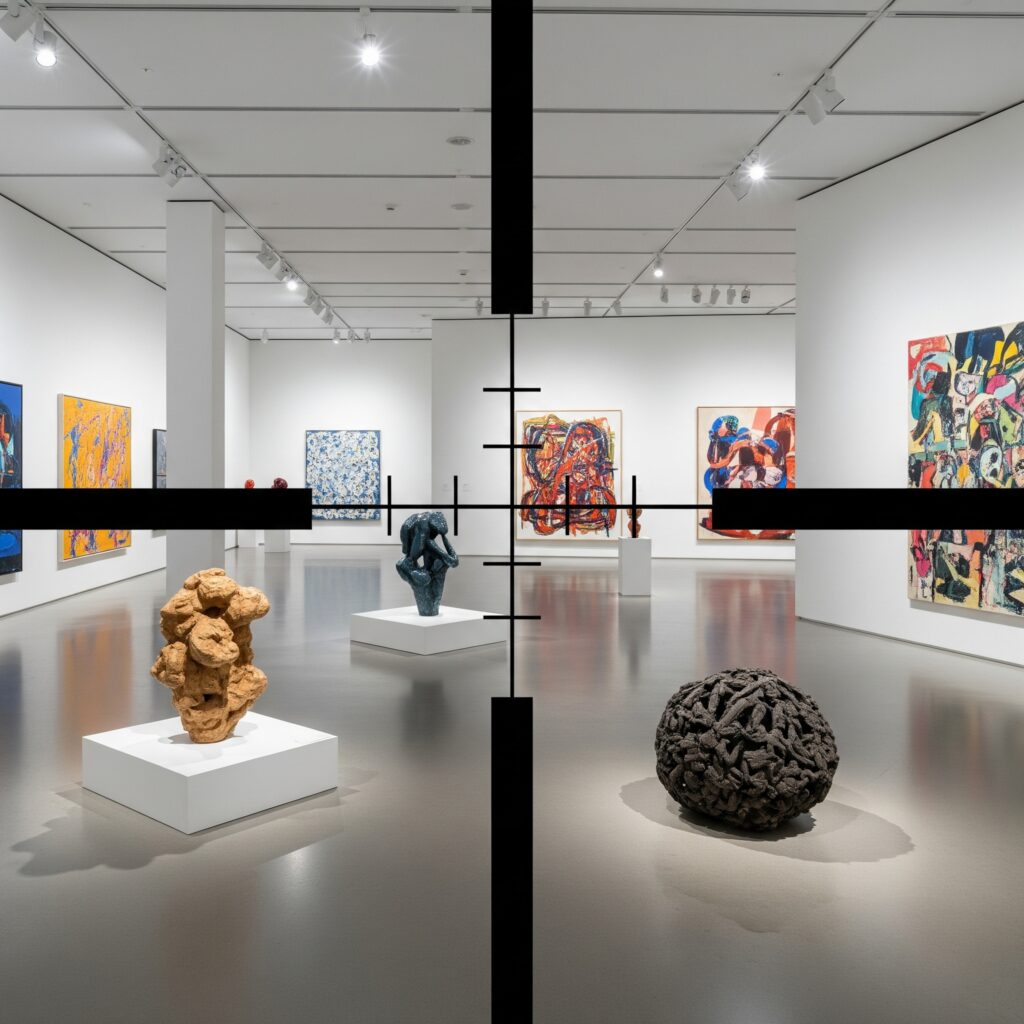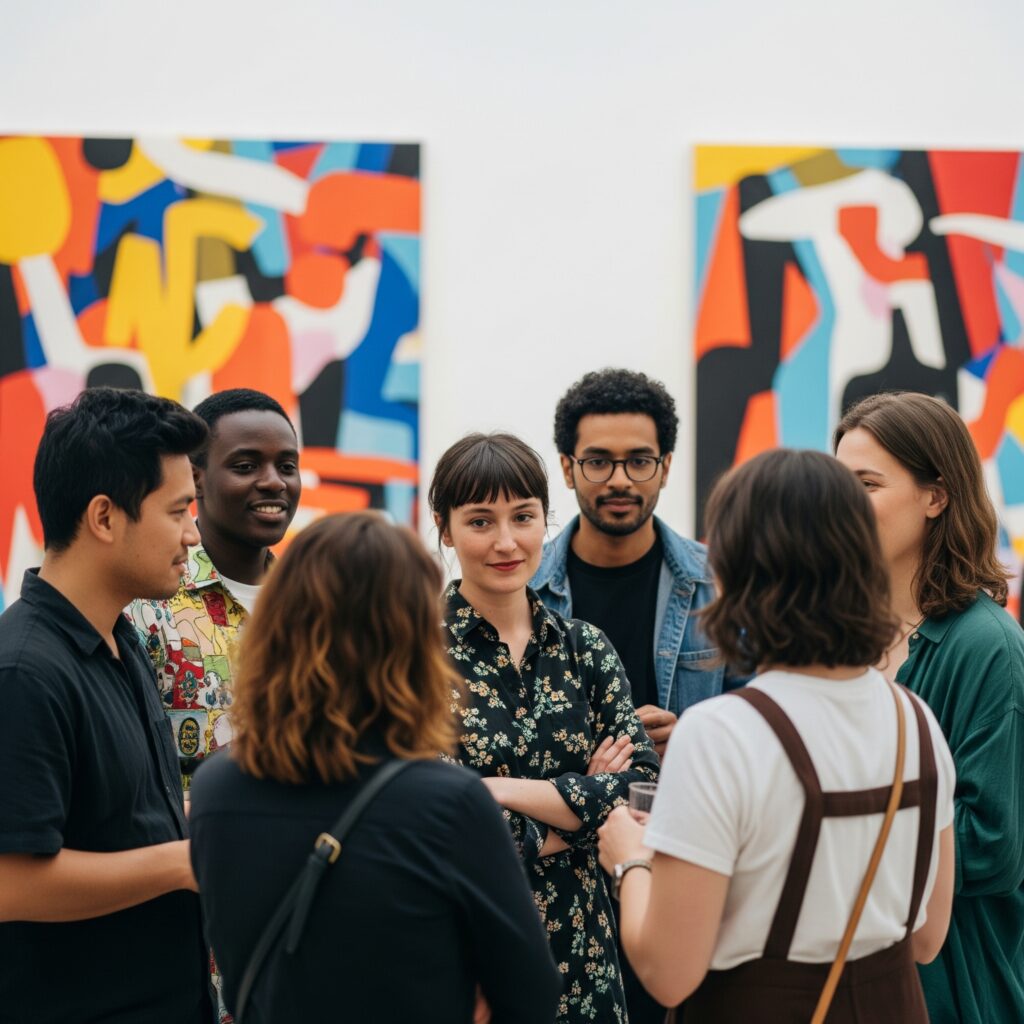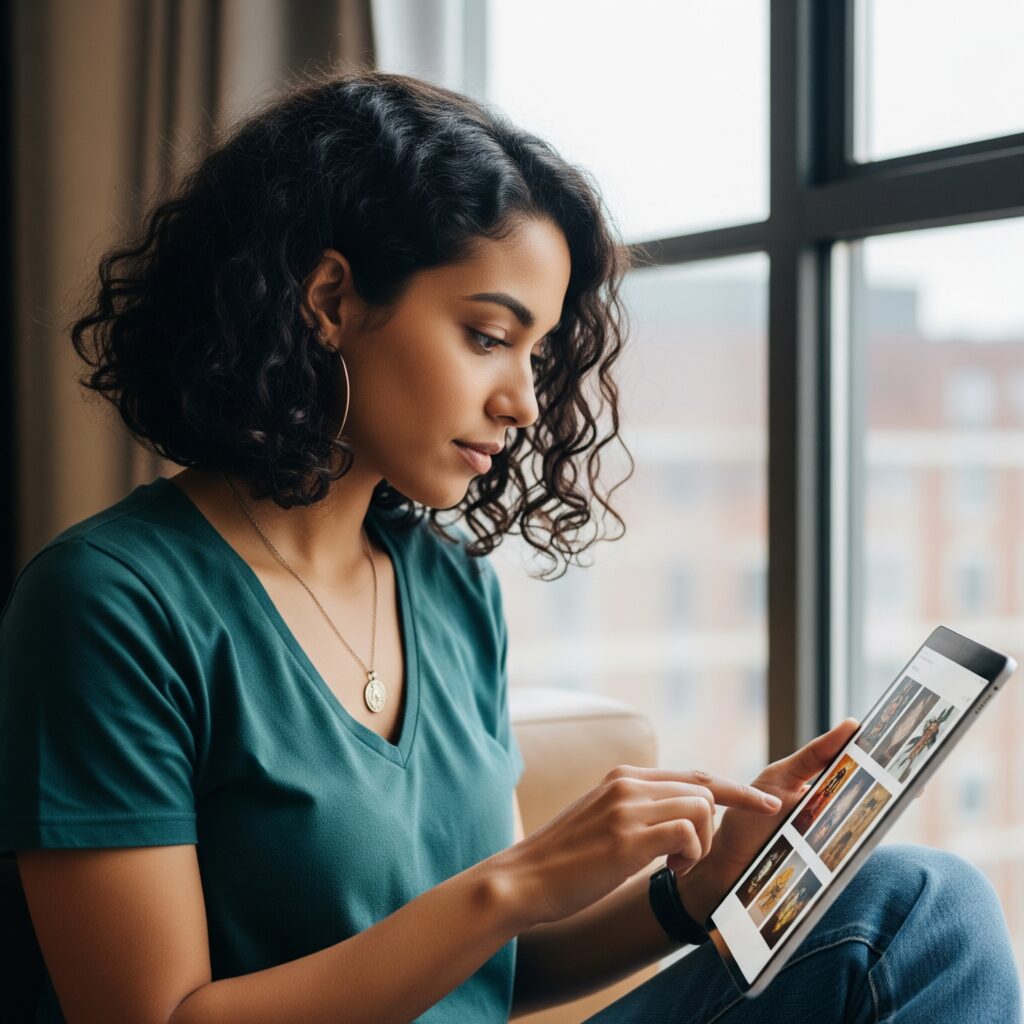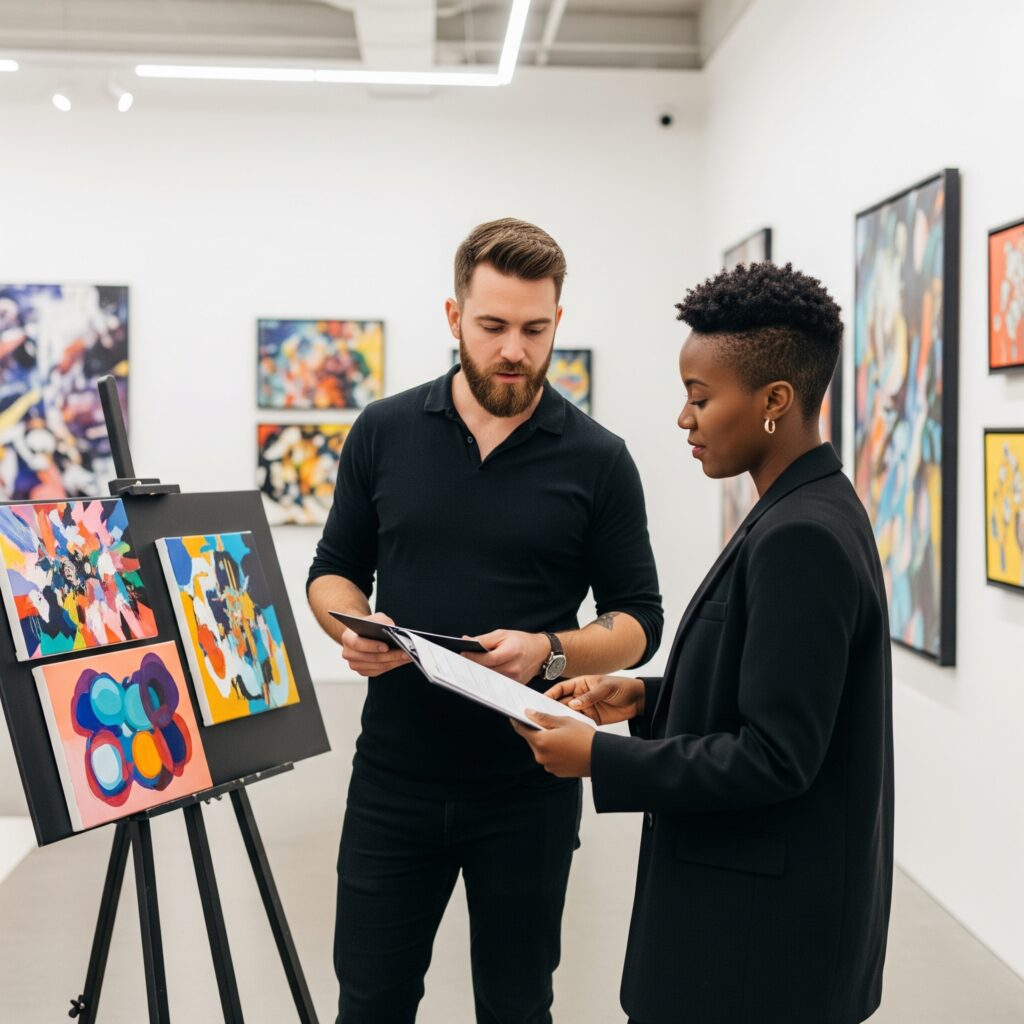For many emerging artists, securing gallery representation is a pivotal milestone in their professional journey. Not only do art galleries provide exhibition space but also credibility, exposure to collectors, and potential sales opportunities that can transform an artistic hobby into a sustainable fulltime-career.
However, let’s face it: With countless talented artists vying for limited gallery slots, the process of getting noticed can seem daunting and mysterious.
Our comprehensive guide aims to show you the path to gallery recognition, offering actionable strategies that go beyond generic advice to help you effectively showcase your artwork to the right audiences.
- 1 1. Prepare Your Art: Quality Over Quantity
- 2 2. Research the Right Galleries: Strategic Targeting
- 3 3. Network Strategically: Building Authentic Relationships
- 4 4. Submit Proposals Effectively: Professionalism Matters
- 5 5. Leverage Online Platforms: Digital Visibility Matters
- 6 6. Follow Up Effectively: Persistence Without Pressure
- 7 7. Five Common Mistakes to Avoid
- 8 Conclusion: Persistence and Professionalism Pay Off
1. Prepare Your Art: Quality Over Quantity
Before approaching any gallery, make sure your work is truly ready for professional representation. Galleries are on the lookout for artists who demonstrate consistency, technical proficiency, and a distinctive style. Your portfolio should reflect a consistent body of work rather than disconnected pieces that showcase various styles or techniques.
Building a Bulletproof Portfolio
Focus on developing a series of 10-15 pieces that clearly communicate your artistic vision. These works should be thematically or stylistically connected, allowing viewers to immediately recognize your unique perspective. Remember that galleries are looking for artists whose work tells a compelling story and fits within their curatorial vision. Therefore:
- Create work that demonstrates technical mastery in your medium of choice
- Develop a recognizable style or approach that distinguishes your art
- Keep up consistency in quality across your portfolio
- Select pieces that show depth of concept and execution
- Include only your strongest work—quality always trumps quantity
Professional Documentation
High-quality documentation of your artwork is non-negotiable, because poor images can undermine even the most exceptional art. Invest in professional photography or learn proper documentation techniques to always present your work in its best light!
- Capture high-resolution images (300 DPI minimum) with accurate color representation
- Photograph work unframed against a neutral background unless the frame is integral
- Include detail shots for textured or intricate works
- Maintain consistent lighting and perspective across all documentation
- Save files in multiple formats (TIFF for archiving, JPG for sharing)
Carefully Craft Your Artist Statement
A compelling artist statement contextualizes your work and provides insight into your creative process. Keep it concise (250-300 words), avoid jargon, and focus on clearly articulating the concepts, inspirations, and techniques that inform your practice.
2. Research the Right Galleries: Strategic Targeting

Thorough gallery research increases your chances of finding the right match for your work
Not all galleries are created equal, and submitting to the wrong ones wastes both your time and theirs. So remember, effective research helps you identify institutions that align with your artistic vision, preferred medium, and career stage.
How to Identify Suitable Art Galleries
Begin by analyzing galleries that exhibit work similar to yours in style, medium, or concept. Consider whether your art would complement their existing roster without being redundant or your style deviating too far from that of the artists they represent. Also, look for those that represent artists at a similar career stage—artists, that are one step ahead of where you currently stand.
Local vs. International
It’s always a good idea to start with art galleries in your geographic area, as local representation often provides more hands-on support and opportunities for in-person collaboration. However, don’t limit yourself geographically if your work aligns perfectly with a gallery elsewhere, especially in the digital age where remote relationships are increasingly common.
Niche vs. Mainstream
Consider whether your work fits better in specialized galleries focused on particular styles or media, or if it has broader appeal. Niche galleries often have dedicated collector bases passionate about specific types of art, while mainstream galleries may offer wider exposure but face more competition.
Essential Research Tools
- Gallery Directories: Utilize resources like Artsy, ArtFacts, and GalleriesNow to discover galleries by location and specialty
- Social Media: Follow them on Instagram to understand their aesthetic and programming
- Art Fairs: Visit local and international art fairs to see multiple art galleries in one location
- Gallery Websites: Examine their artist roster, past exhibitions, and submission policies
- Art Publications: Review advertisements and exhibition reviews in art magazines
Pro Tip: Create a spreadsheet to track galleries of interest, including their focus, current portfolio, submission requirements, and any connections you might have. Rate each gallery’s compatibility with your work on a scale of 1-10 to prioritize your outreach efforts.
3. Network Strategically: Building Authentic Relationships

Gallery openings provide valuable opportunities to connect with curators and fellow artists
In the art world, relationships often open up opportunities. Effective networking isn’t about aggressive self-promotion but rather about becoming a valued member of the art community. Building authentic connections with curators, art directors, and fellow artists can open doors that would remain closed to unsolicited submissions.
Attend Gallery Openings and Events
Regular attendance at openings demonstrates your engagement with the local art scene and provides natural opportunities to meet gallery staff. Focus on being genuinely interested in the exhibited work rather than immediately steering conversations toward your own practice.
- Research the exhibition before attending to enable informed conversations
- Attend regularly to become a familiar face in the gallery community
- Ask thoughtful questions about the work and curatorial decisions
- Connect with fellow attendees who share your artistic interests
- Follow up with new connections via email or social media
How To Get Your Art Noticed By Galleries? Build Relationships with Curators!
Curators are constantly searching for new talent, but they prefer discovering creative people through trusted channels rather than cold submissions. Position yourself as a serious artist worthy of attention by engaging meaningfully with their programming.
Leverage Artist Communities
Fellow artists can be your most valuable allies. Join studio collectives, artist-run spaces, and professional organizations to expand your network. Artists already represented by art galleries may recommend your work if they believe in your practice and see alignment with their art gallery’s program.

Studio visits offer curators an in-depth look at your practice and working methods
4. Submit Proposals Effectively: Professionalism Matters
When the time comes to formally approach galleries, professionalism in your presentation can make all the difference between consideration and rejection. Gallery directors constantly receive submissions and quickly filter out those that appear unprofessional, do not fit to their portfolio or fail to follow guidelines.
Craft a Compelling Submission Package
Your submission package should be comprehensive yet concise, providing all the information a gallery needs to evaluate your work without overwhelming them. Tailor each submission to the specific art gallery rather than sending identical packages to multiple venues. What you could include:
- Portfolio: 10-15 high-resolution images of your strongest, most recent work
- CV: A professional artist CV highlighting exhibitions, education, awards, and relevant experience
- Artist Statement: A concise explanation of your artistic practice and conceptual framework
- Cover Letter: A personalized introduction explaining your interest in the specific gallery
- Supporting Materials: Press coverage, exhibition catalogs, or videos if relevant
Follow Gallery Guidelines Strictly
Each gallery has specific submission requirements regarding format, timing, and content. Failing to follow these guidelines can signal that you may be difficult to work with or haven’t done your research.
Common Submission Mistakes to Avoid:
- Don’t send unsolicited physical materials to galleries that don’t accept them
- Submitting incomplete information or poor-quality images
- Don’t use generic, non-personalized cover letters
- Ignoring file format or size requirements
- Following up too frequently or aggressively
Download Your Free Gallery Submission Checklist
Never miss a crucial element in your gallery submissions again. Our comprehensive checklist covers everything you need to prepare before approaching art galleries, ensuring your work gets the consideration it deserves.
Use our interactive gallery submission checklist
5. Leverage Online Platforms: Digital Visibility Matters

A well-curated social media presence can attract gallery attention and demonstrate audience engagement
In today’s art world, your online presence serves as a constantly accessible portfolio and networking tool. Galleries increasingly discover new artists through digital platforms, making strategic online visibility essential to getting noticed.
Instagram as a Gallery Tool
Instagram has become the preferred social platform for artists and curators, with curators and gallery directors regularly scouting for new talent. Look at your Instagram account as a curated exhibition space rather than a casual social feed.
- Post high-quality, consistent images of your work with professional lighting
- Develop a cohesive visual grid that reflects your artistic identity
- Use relevant hashtags that gallery professionals monitor (#emergingartist, #contemporarypainting, etc.)
- Tag art galleries you admire when attending their exhibitions (but never tag them in your artwork)
- Engage with galleries’ content through thoughtful comments
Create a Professional Portfolio
While social media provides visibility, a professional website offers comprehensive presentation of your work. Your portfolio should function as a digital portfolio that galleries can easily navigate to understand your practice.
Essential Website Elements
- Portfolio pages organized by series or projects
- Artist statement and biography
- CV with exhibition history
- Press coverage and publications
- Contact information
Technical Considerations
- Mobile-responsive design
- Fast loading images
- Clean, minimal layout that prioritizes your work
- Easy navigation
- SEO optimization for relevant search terms
A professional website serves as your digital portfolio and information hub for galleries.
6. Follow Up Effectively: Persistence Without Pressure
The art of following up has to be mastered. You have to balance persistence with respect for the curators’s time and processes. Effective follow-up demonstrates your continued interest without creating pressure or appearing desperate.
Polite Email Templates
Prepare professional templates for different follow-up scenarios that you can customize for each art gallery. These should be concise, respectful, and include all necessary reference information. You could use something like this:
Initial Follow-Up Template (2-3 weeks after submission)
Subject: Follow-up: [Your Name] Submission – [Date of Original Submission]
Dear [Director’s Name],
I hope this email finds you well. I’m writing to follow up on the portfolio materials I submitted on [date] for your consideration. I understand you receive many submissions and review processes take time, so I simply wanted to confirm receipt of my materials and inquire if you need any additional information from me.
I remain very interested in your gallery’s program, particularly after seeing your recent exhibition of [mention specific show that resonated with you].
Thank you for your time and consideration.
Best regards,
[Your Name]
[Your Website]
[Your Phone Number]
How to Handle Rejection Constructively
Rejection is an inevitable part of an artist’s journey to gallery representation. How you respond to rejection can impact future opportunities with the same gallery.
- Thank the gallery for their consideration and time
- Ask for feedback if appropriate (but don’t expect it)
- Continue to engage with the gallery as an appreciative visitor
- Use rejection as an opportunity to reassess and strengthen your work
- Maintain the relationship for potential future opportunities
7. Five Common Mistakes to Avoid
Understanding common pitfalls can help you avoid critical mistakes in your gallery approach
Effective Approaches
- Researching art galleries thoroughly before submission
- Building authentic relationships within the art community
- Presenting professionally documented work
- Personalizing communications to each gallery
- Demonstrating patience and persistence
Common Mistakes
- Spamming galleries with mass submissions
- Presenting inconsistent or underdeveloped work
- Using poor-quality documentation
- Ignoring gallery submission guidelines
- Following up too aggressively
Mistake #1: Submitting Before Your Work is Ready
Many artists approach galleries prematurely, before developing a cohesive body of work. Galleries look for creatives with a clear direction and consistent quality. Submit only when you have 10-15 strong pieces that demonstrate a unified vision.
Mistake #2: Ignoring Gallery Focus
Each gallery has a specific program and aesthetic direction. Submitting artwork that doesn’t align with their focus wastes everyone’s time and can damage your professional reputation. Research thoroughly and target only art galleries where your pieces would complement their existing program.
Mistake #3: Unprofessional Presentation
Poor-quality images, typo-filled statements, or disorganized materials signal a lack of professionalism. Galleries seek artists who are not only talented but also reliable and professional. Invest time in creating polished, error-free submission materials.
Mistake #4: Relying Solely on Submissions
Many artists make the mistake of relying exclusively on formal submissions rather than building relationships. While submissions have their place, most gallery relationships begin through personal connections, recommendations, or in-person encounters.
Mistake #5: Taking Rejection Personally
Rejection is rarely about the quality of your work alone. Galleries consider many factors, including their current roster, exhibition schedule, and market considerations. Responding negatively to rejection can close doors permanently, while constructive responses keep possibilities open.
Conclusion: Persistence and Professionalism Pay Off

With preparation and persistence, gallery representation becomes an achievable goal
Securing gallery representation is rarely an overnight achievement but rather the result of strategic preparation, relationship building, and professional persistence. By developing a strong body of work, researching appropriate art galleries, building authentic relationships, submitting professionally, leveraging online platforms, and following up effectively, you significantly increase your chances of getting your art noticed by galleries.
Remember that the journey to representation is as much about developing yourself as a professional as it is about creating compelling artwork. Galleries seek not only talented artists but reliable partners who understand the business aspects of the art world and can contribute positively to their program.
As you implement these strategies, maintain patience and resilience. Most successful artists faced numerous rejections before finding the right gallery fit. Each interaction, whether it leads to immediate opportunity or not, contributes to your professional development and visibility in the art world.
